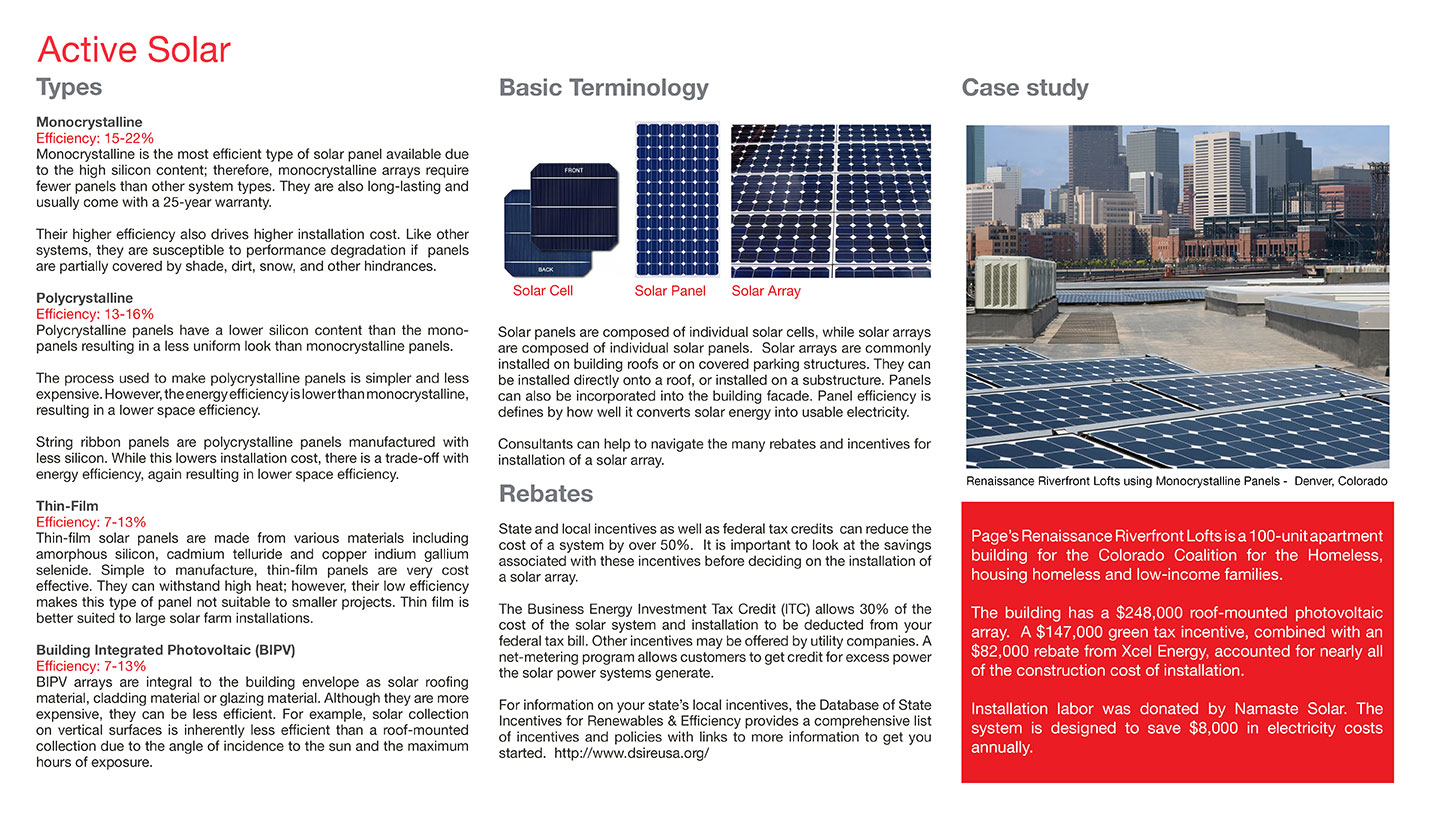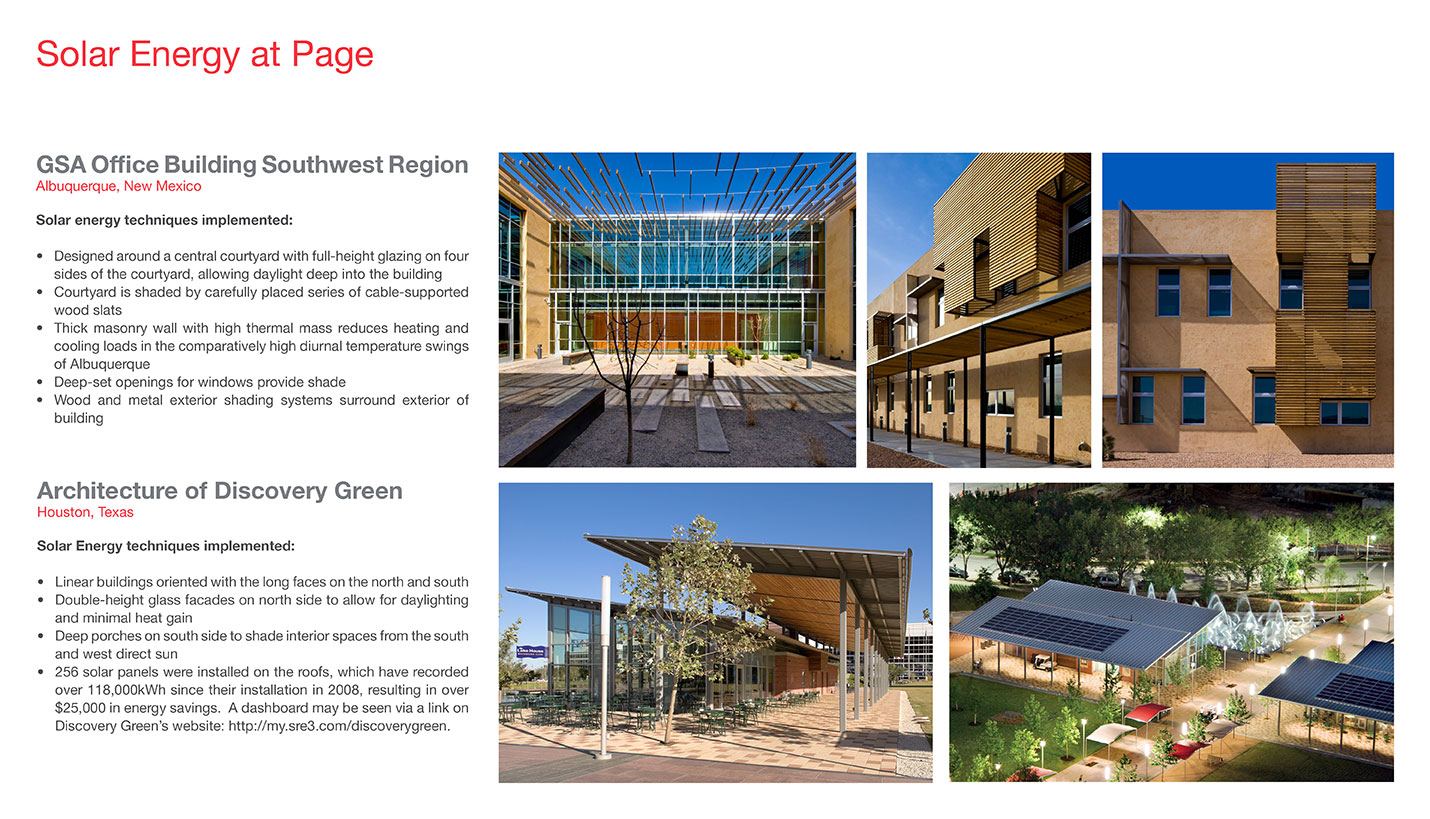On-Site Renewable Energy: Solar
Two of Page's sustainability experts, Mackenzie Manson and Joanna Yaghooti, recently collaborated on a brief overview of the use of solar energy as part of an overall strategy to conserve resources and promote energy independence. They compare passive versus active solar design strategies, and explores the differences between the various types of solar panels.
Passive Design
Passive solar is a design strategy focused on the thoughtful design of windows, walls and floors to collect and distribute solar energy in a building. This simple strategy requires little to no mechanical or electrical systems (and no moving parts). Vernacular architecture is well known for its intuitive use of passive solar design.
Passive solar strategies include orienting the building in response to the sun’s path, shading the building, using materials with favorable thermal mass properties for the climate, and designing the interior spaces of the building to assist in effectively heating and cooling the building naturally. Passive solar technologies reduce the building’s reliance on mechanical and electrical systems to heat, cool and light the building. It is a foundation on which high performance buildings are conceived.
Active Design
Active solar technology uses equipment to convert solar energy into usable electricity or to heat water for process or domestic use in the building. These technologies are steadily evolving and their efficiency is improving rapidly.
Fall 2014 competitive pricing puts a typical roof-mounted installation at approximately $3-3.50/ watt (inclusive of material, labor, inverters, mounting and electrical, but exclusive of incentives and rebates). A typical mid-rise office building (approximately 130,000 gsf) can expect to install an array comprising 154 250w panels for approximately $115,000 (before rebates). Depending on the building’s load profile, a system at this scale can be expected to mitigate up to 6-10% of the building’s energy demand. Regional variations can greatly affect production and installation costs.
Passive design considerations
Microclimate
- Buildings in humid environments require different passive strategies than buildings in an arid climate.
Building Orientation
- Position long side of building in a north-south orientation whenever possible.
Fenestration Orientation
- Size and configure windows to minimize heat loss.
- Shade windows to further minimize heat loss.
Thermal Mass
- Design solid walls with thermal properties that follow vernacular rules regarding storage and release of heat.
Active design considerations
Large unobstructed roofs or ground areas are ideal for photovoltaic panel arrays. Trees, mechanical units and other buildings should not shade the panels at any time.
Panels typically produce the most energy when tilted at the correct angle equal to the latitude of the sun at that specific location. Designers to determine the optimal solar panel installation angle.
For buildings with smaller floor plates, consider installing panels on parking structures or covered parking pavilions.
Install an energy dashboard for tracking and displaying the array’s performance. The energy dashboard also educates the building occupants on how their behaviors impact building performance.
The entire post is available as a PDF document under "Blog Resources" on the right.
Contributed By
Mackenzie Manson, LEED AP BD+C and Joanna Yaghooti, AIA, LEED AP BD+C, BREEAM AP, PQP
09/18/2014
Blog Resources
Related Posts
- Green Building Financing
- Net Zero Water
- Case Study: Creating an Energy Efficient, Intelligent Building in Finland
- Case Study: Sustainable Design at University of Colorado - Colorado Springs
- Sustainability in Action at Page
- Faster building performance analysis helps architects meet AIA 2030 goals
- Tempering the Temporary: Improving thermal comfort and safety in relief shelters












